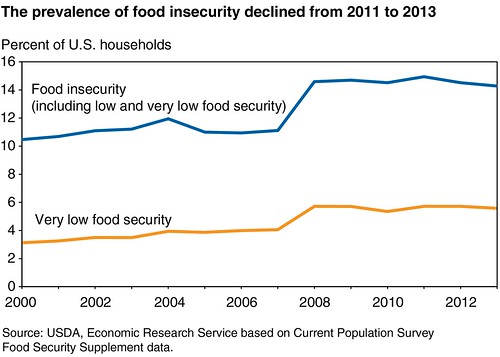
USDA’s latest report on food insecurity in America shows that the prevalence of food insecurity is down from a high of 14.9 percent of U.S. households in 2011 to 14.3 percent in 2013. This annual report takes a look at the number and types of households that had difficulty at some time during the year providing enough food for all their members due to a lack of financial or other resources. Back in 2007, about 11 percent of U.S. households were food insecure, but with the economic downturn in 2008, that rate had increased and remained relatively high.
Given improvements in employment and other economic indicators, some have wondered why food security has been slow to improve. A recent study by my colleagues and me at the Economic Research Service sheds light on this question. We found that while unemployment declined in 2012 and 2013, inflation and the price of food relative to other goods and services continued to increase. These increases offset improvements in food security that might have resulted from the decline in unemployment. This study provides a useful backdrop to understanding trends in and causes of food insecurity.
The USDA annual report also includes statistics on food insecurity in different types of households. We find that in general, households with children have higher food insecurity rates than those without children. In 2013, one-in-five households with children were food insecure. Most parents try to protect their children from food insecurity, to the extent they can. So in about half of these food-insecure households, only adults were food insecure.
But both children and adults were food insecure in 9.9 percent of households with children—meaning that these 3.8 million households were unable to provide adequate, nutritious food for their children at times during the year. A subset of these households—0.9 percent of all households with children (360,000 households) —faced food insecurity so severe that parents reported that children were hungry, skipped a meal, or did not eat for a whole day because there was not enough money for food. This subset of households with children was down from 1.2 percent in 2012.
You can see more statistics on the incidence and severity of food insecurity by demographic characteristics, across States, and over time in Household Food Security in the United States in 2013.
